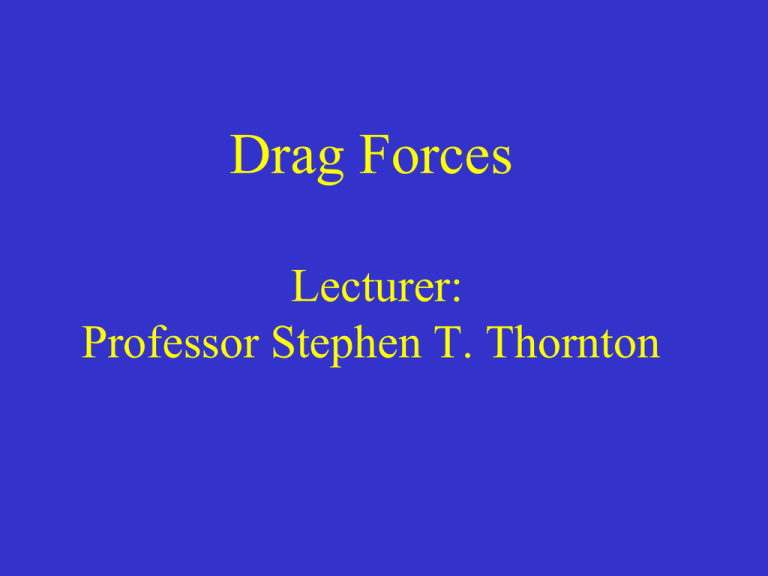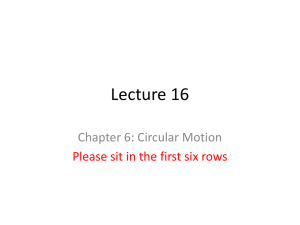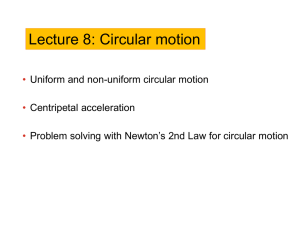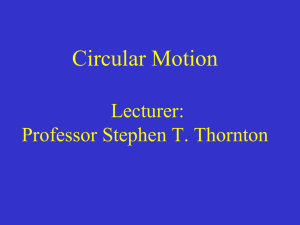Lecture 10.DragForce.. - Faculty Web Sites at the University of Virginia
advertisement

Drag Forces Lecturer: Professor Stephen T. Thornton Reading Quiz A skier goes over a small round hill A) Fc = N + mg with radius R. Because she is in B) Fc = mg – N circular motion, there has to be a C) Fc = T + N – mg centripetal force. At the top of the D) Fc = N hill, what is Fc of the skier equal to? E) Fc = mg v R Reading Quiz A skier goes over a small round hill A) Fc = N + mg with radius R. Because she is in B) Fc = mg – N circular motion, there has to be a C) Fc = T + N – mg centripetal force. At the top of the D) Fc = N hill, what is Fc of the skier equal to? Fc points toward the center of the circle (i.e., downward in this case). The weight vector points down and the normal force (exerted by the hill) points up. The magnitude of the net force, therefore, is Fc = mg – N. E) Fc = mg v mg N R Follow-up: What happens when the skier goes into a small dip? Last Time Circular motion Motion on banked curves Lots of Conceptual Quizzes Today Non-uniform circular motion Drag Terminal velocity Fundamental forces Banked Curve. A curve of radius 68 m is banked for a design speed of 85 km/h. If the coefficient of static friction is 0.30 (wet pavement), at what range of speeds can a car safely make the curve? [Hint: Consider the direction of the friction force when the car goes too slow or too fast.] Conceptual Quiz In the game of tetherball, the struck ball whirls around a pole. In what direction does the net force on the ball point? A) toward the top of the pole B) toward the ground C) along the horizontal component of the tension force D) along the vertical component of the tension force E) tangential to the circle T W Conceptual Quiz In the game of tetherball, the struck ball whirls around a pole. In what direction does the net force on the ball point? A) toward the top of the pole B) toward the ground C) along the horizontal component of the tension force D) along the vertical component of the tension force E) tangential to the circle The vertical component of the tension balances the weight. The horizontal component of tension provides the centripetal force that points toward the center of the circle. W T T W Conceptual Quiz You drive your car too fast around a curve and the car starts to skid. What is the correct description of this situation? A) car’s engine is not strong enough to keep the car from being pushed out B) friction between tires and road is not strong enough to keep car in a circle C) car is too heavy to make the turn D) a deer caused you to skid E) none of the above Conceptual Quiz You drive your car too fast around a curve and the car starts to skid. What is the correct description of this situation? A) car’s engine is not strong enough B) C) D) E) to keep the car from being pushed out friction between tires and road is not strong enough to keep car in a circle car is too heavy to make the turn a deer caused you to skid none of the above The friction force between tires and road provides the centripetal force that keeps the car moving in a circle. If this force is too small, the car continues in a straight line! Follow-up: What could be done to the road or car to prevent skidding? Conceptual Quiz A Ping-Pong ball is shot into a circular tube that is lying flat (horizontal) on a tabletop. When the PingPong ball leaves the track, which path will it follow? Conceptual Quiz A Ping-Pong ball is shot into a circular tube that is lying flat (horizontal) on a tabletop. When the PingPong ball leaves the track, which path will it follow? Once the ball leaves the tube, there is no longer a force to keep it going in a circle. Therefore, it simply continues in a straight line, as Newton’s First Law requires! Follow-up: What physical force provides the centripetal force? Conceptual Quiz You swing a ball at the end of string A) Fc = T – mg in a vertical circle. Because the ball B) Fc = T + N – mg is in circular motion there has to be a C) Fc = T + mg centripetal force. At the top of the D) Fc = T ball’s path, what is Fc equal to? E) Fc = mg top v R Conceptual Quiz You swing a ball at the end of string A) Fc = T – mg in a vertical circle. Because the ball B) Fc = T + N – mg is in circular motion there has to be a C) Fc = T + mg centripetal force. At the top of the ball’s path, what is Fc equal to? Fc points toward the center of the circle (i.e., downward in this case). The weight vector points down and the D) Fc = T E) Fc = mg v mg T tension (exerted by the string) also points down. The magnitude of the net force, therefore, is Fc = T+ mg. R Conceptual Quiz A rider in a “barrel of fun” finds herself stuck with her back to the wall. Which diagram correctly shows the forces acting on her? A B C D E Conceptual Quiz A rider in a “barrel of fun” finds herself stuck with her back to the wall. Which diagram correctly shows the forces acting on her? A B C The normal force of the wall on the rider provides the centripetal force needed to keep her going around in a circle. The downward force of gravity is balanced by the upward frictional force on her, so she does not slip vertically. See http://physics.bu.edu/~duffy/semester1/semester1.html D E Nonuniform Circular Motion If an object is moving in a circular path but at varying speeds, it must have a tangential component to its acceleration as well as the radial one. Nonuniform Circular Motion This concept can be used for an object moving along any curved path, as any small segment of the path will be approximately circular. Drag Forces 1 FD = r ACD v 2 2 Here, FD is the drag force; ρ the density of the medium; A the cross-sectional area of the object; CD the drag coefficient. Velocity-Dependent Forces: Drag and Terminal Velocity When an object moves through a fluid at low speed, it experiences a drag force that depends on the velocity of the object. FD bv For small velocities, the force is approximately proportional to the velocity; for higher speeds, the force is approximately proportional to the square of the velocity. 2 FD v If the drag force on a falling object is proportional to its velocity, the object gradually slows until the drag force and the gravitational force are equal. Then it falls with constant velocity, called the terminal velocity (~120 mph for humans). mg bv when equal, no net force mg vT terminal velocity b Simplified Top View of a Centrifuge in Operation More dense Less dense Separate red and white blood cells from serum. anemia 45% Centrifuges Centrifuges have many uses. • Separating red and white blood cells from serum. • Separating 235U from 238U to produce fissionable material. • Separating large molecules from smaller molecules for research and pharmaceutical purposes. Fundamental Forces • Universal gravitation: gravitational force between any two masses • Electroweak force: includes electric, magnetic, and weak nuclear forces (responsible for radioactive decay) • Strong (nuclear) force: binds protons and neutrons together in nucleus Conceptual Quiz A box of weight 100 N is at rest on a floor where ms = 0.4. A rope is attached to the box and pulled horizontally with tension T = 30 N. Which way does the box move? A) moves to the left B) moves to the right C) moves up D) moves down E) the box does not move Static friction (ms = 0.5 ) m T Conceptual Quiz A box of weight 100 N is at rest on a floor where ms = 0.4. A rope is attached to the box and pulled horizontally with tension T = 30 N. Which way does the box move? A) moves to the left B) moves to the right C) moves up D) moves down E) the box does not move The static friction force has a maximum of msN = 40 N. The tension in the rope is only 30 N. Static friction (ms = 0.4 ) m T So the pulling force is not big enough to overcome friction. Follow-up: What happens if the tension is 35 N? What about 45 N?







